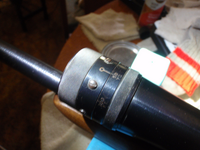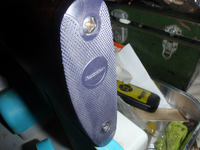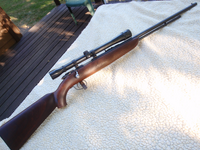Silver Supporter
Bronze Supporter
- Messages
- 4,214
- Reactions
- 6,921
In a relatively recent thread I described a Remington Model 512 I purchased that triggered (pun intended) memories of teenaged competition with a 513T. I closed that with noting the rifle might deserve a better scope, and the exceptional wood (under dark varnish) needed to be seen.
The optics were the result of researching what was available in 1959 (the year this 512 came kicking and screaming from the womb in Ilion, New York). Previously, I have given myself license when outfitting classic rifles with optics, leaning on the valid premise that most working men most often bought rifles (of ANY type) sans scopes and nearly quite as often did find the funds to scope them somewhat later. Thus, in my estimation there is some wiggle room on the higher end of the calendar where "period correct" may not actually be precise to the gun's age. I gave myself A LOT of license putting the Bushnell Custom .22 (1970's vintage) on this 512 to start with, justifying it to myself by saying it was entirely possible that the rifle was shot with buckhorns until the 1970's when really excellent rimfire scopes were produced.
That's called rationalization.
In 1959, (according to Gun Digest) rimfire scopes (then only 3/4 or 7/8 tube) were offered by Weaver (B series), and .22 rifle manufacturers: Marlin, Mossberg, and Colt's (for their "Colteer" .22 bolt gun). Who knows who really built those? The ubiquitous 3/8 dovetail rimfire mount, called "tip-off" (no, it didn't rotate out of line of sight like a Weaver swing mount so I have no idea why) was a brand new thing. The Weaver K10 (and K8) was also a new thing. So when I located one in my "Island of Misfit Optics", that made it a precisely "period correct" scope for a 512 owner wanting maximum magnification: for Woodchucks, Greydiggers, and all them hunnerd yard varmints that plagued the nation in 1959.
The fly in the ointment is that the concept of ANY sporting .22 deserving a 1" tubed scope back then was unheard of (outside the target shooting realm of course: the K10 was a very popular enhancement for serious .22's like a 40x, but it would be installed in the drilled receiver, not a 3/8 dovetail) . So "period correct" 3/8 dovetail 1" tube rings would be problematic. In 2023, a demure set of basic Burris rimfire rings would serve and nearly disappear in the assembly. To "authentically" mount a K10 on a 512 (and I'm certain it was done back then), the owner would have a Smith drill holes right on top of that 3/8 dovetail. A pleasant surprise was that clearance over the buckhorn was minimal, and barrel clearance of the objective down low where it should be. Perfect!
The best feature of this scope selection is not on the target (the little Bushnell's glass allowed this gun at 50 yards to do what it could do). The Weaver bluing matches Remington "to a 'T' ".
These are wonderfully rugged scopes, far ahead of their time, complete with Adjustable Objective, Click Dials and brilliant glass (though certainly lacking more modern chemical coatings). Ten Power at 50 yards in sharp focus with all parallax removed is a feeling of control. These scopes were built for high power recoil, and saw hard work on the early big long-range magnums when they were being developed and promoted. On a .22 they relax.

The Weaver K10's adjustable objective removes parallax from 50ft to 1000yds, and the bluing looks like it came from the same tank as the Remington 512.
As to the wood, it had been modified at the pistol grip by a previous owner to a sort of "palm swell", indications of a screw hole where a grip cap had been, the buttplate was broken and a home varnish job (apparently without removing the action from the stock) darkened and obscured what looked promising toward figure in the grain.
At first finish removal and view, it did not disappoint. There was gold in them thar hills. A buttplate of New Old Stock was located to be fitted at sanding. The palm swell was refined and the flutes of it at the comb defined toward making it all look like a factory offering.

A NOS buttplate was a good find and was fitted at sanding stage.

The burl that was hidden under dark varnish, and toward the forend it straightens out just like it should. Grip cap and flute bevel show here as well.
The missing grip cap (originally there was none on a 512) was replaced with a slice of Black Walnut, fitted and shaped toward a tribute to the later 541's that sported a wood-grain cap.
Then I bumped into something on Ebay.
A seller there had Remington Firearm Inspector tags (or awfully old reproductions): A shield medallion. Inletted, it would fit inside the circumference of the cap! I ordered two (ya never know). There was a disclaimer that no "search" would be done for a specific number inscription. You guessed it. I tried for "512", got 511 and 712. She was very gracious when I explained what it was for. Close enough, and Thank ya, Ma'am!

Trigger pull was crisp and tight, but just under 5 lbs. Research showed a slightly weaker trigger spring, cleaning of all moving parts and polishing sear contact surfaces was all that could be done, with huge warnings about going too far. That scared me so I didn't mess there much, cleaned every single part, and installed a spring that delivered 3.1 lbs.
But the safety detent (that operated on trigger spring tension) did not work well and the safety could be brushed on and off too easily. Another disassembly, a mid-road spring, courage toward a bit of polishing and it now puts out at 3.7 with a reliable safety that stays put. Squirrel gun ideal. The "concept" of this gun (as it developed along the way) is an outfit that would be the very best .22 in the field in 1959 for Woodchucks in the East and Silver Greys out here on the Coast. September is just around the corner and this Remington needs to go to work.
Ladies and Gentlemen, I present to you, The Inspector:

The optics were the result of researching what was available in 1959 (the year this 512 came kicking and screaming from the womb in Ilion, New York). Previously, I have given myself license when outfitting classic rifles with optics, leaning on the valid premise that most working men most often bought rifles (of ANY type) sans scopes and nearly quite as often did find the funds to scope them somewhat later. Thus, in my estimation there is some wiggle room on the higher end of the calendar where "period correct" may not actually be precise to the gun's age. I gave myself A LOT of license putting the Bushnell Custom .22 (1970's vintage) on this 512 to start with, justifying it to myself by saying it was entirely possible that the rifle was shot with buckhorns until the 1970's when really excellent rimfire scopes were produced.
That's called rationalization.
In 1959, (according to Gun Digest) rimfire scopes (then only 3/4 or 7/8 tube) were offered by Weaver (B series), and .22 rifle manufacturers: Marlin, Mossberg, and Colt's (for their "Colteer" .22 bolt gun). Who knows who really built those? The ubiquitous 3/8 dovetail rimfire mount, called "tip-off" (no, it didn't rotate out of line of sight like a Weaver swing mount so I have no idea why) was a brand new thing. The Weaver K10 (and K8) was also a new thing. So when I located one in my "Island of Misfit Optics", that made it a precisely "period correct" scope for a 512 owner wanting maximum magnification: for Woodchucks, Greydiggers, and all them hunnerd yard varmints that plagued the nation in 1959.
The fly in the ointment is that the concept of ANY sporting .22 deserving a 1" tubed scope back then was unheard of (outside the target shooting realm of course: the K10 was a very popular enhancement for serious .22's like a 40x, but it would be installed in the drilled receiver, not a 3/8 dovetail) . So "period correct" 3/8 dovetail 1" tube rings would be problematic. In 2023, a demure set of basic Burris rimfire rings would serve and nearly disappear in the assembly. To "authentically" mount a K10 on a 512 (and I'm certain it was done back then), the owner would have a Smith drill holes right on top of that 3/8 dovetail. A pleasant surprise was that clearance over the buckhorn was minimal, and barrel clearance of the objective down low where it should be. Perfect!
The best feature of this scope selection is not on the target (the little Bushnell's glass allowed this gun at 50 yards to do what it could do). The Weaver bluing matches Remington "to a 'T' ".
These are wonderfully rugged scopes, far ahead of their time, complete with Adjustable Objective, Click Dials and brilliant glass (though certainly lacking more modern chemical coatings). Ten Power at 50 yards in sharp focus with all parallax removed is a feeling of control. These scopes were built for high power recoil, and saw hard work on the early big long-range magnums when they were being developed and promoted. On a .22 they relax.

The Weaver K10's adjustable objective removes parallax from 50ft to 1000yds, and the bluing looks like it came from the same tank as the Remington 512.
As to the wood, it had been modified at the pistol grip by a previous owner to a sort of "palm swell", indications of a screw hole where a grip cap had been, the buttplate was broken and a home varnish job (apparently without removing the action from the stock) darkened and obscured what looked promising toward figure in the grain.
At first finish removal and view, it did not disappoint. There was gold in them thar hills. A buttplate of New Old Stock was located to be fitted at sanding. The palm swell was refined and the flutes of it at the comb defined toward making it all look like a factory offering.

A NOS buttplate was a good find and was fitted at sanding stage.

The burl that was hidden under dark varnish, and toward the forend it straightens out just like it should. Grip cap and flute bevel show here as well.
The missing grip cap (originally there was none on a 512) was replaced with a slice of Black Walnut, fitted and shaped toward a tribute to the later 541's that sported a wood-grain cap.
Then I bumped into something on Ebay.
A seller there had Remington Firearm Inspector tags (or awfully old reproductions): A shield medallion. Inletted, it would fit inside the circumference of the cap! I ordered two (ya never know). There was a disclaimer that no "search" would be done for a specific number inscription. You guessed it. I tried for "512", got 511 and 712. She was very gracious when I explained what it was for. Close enough, and Thank ya, Ma'am!

Trigger pull was crisp and tight, but just under 5 lbs. Research showed a slightly weaker trigger spring, cleaning of all moving parts and polishing sear contact surfaces was all that could be done, with huge warnings about going too far. That scared me so I didn't mess there much, cleaned every single part, and installed a spring that delivered 3.1 lbs.
But the safety detent (that operated on trigger spring tension) did not work well and the safety could be brushed on and off too easily. Another disassembly, a mid-road spring, courage toward a bit of polishing and it now puts out at 3.7 with a reliable safety that stays put. Squirrel gun ideal. The "concept" of this gun (as it developed along the way) is an outfit that would be the very best .22 in the field in 1959 for Woodchucks in the East and Silver Greys out here on the Coast. September is just around the corner and this Remington needs to go to work.
Ladies and Gentlemen, I present to you, The Inspector:

Last Edited:











